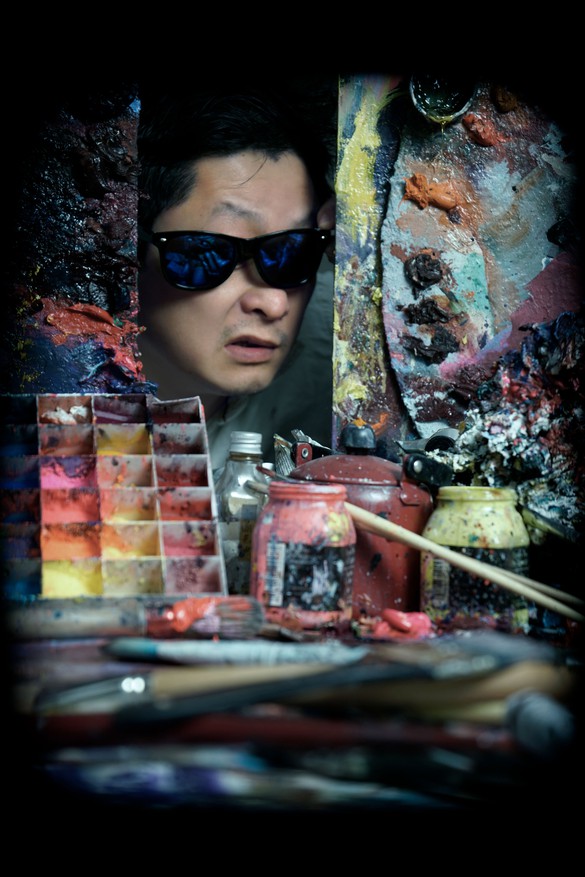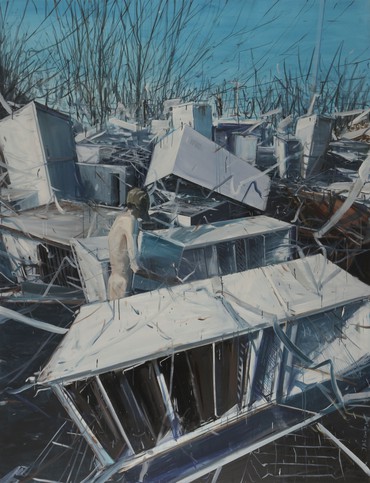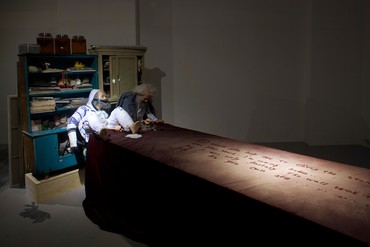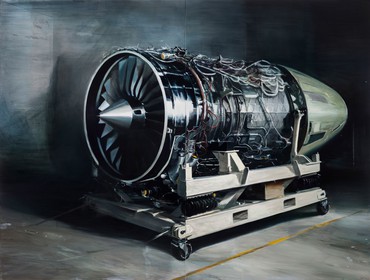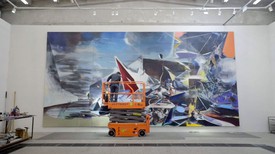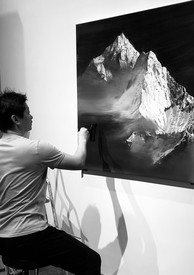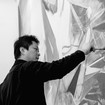
Jia Aili was born in Dandong, China, in 1979 and lives and works in Beijing. In 2004 he graduated from the New Representationalism Studio of the Lu Xun Academy of Fine Arts in Shenyang, China, where he subsequently taught from 2005 to 2007, before focusing exclusively on his career as a painter. He participated in the collateral events of the 54th Venice Biennale in 2011. Photo: Nan Lin
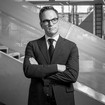
Philip Tinari is the director of UCCA Center for Contemporary Art in Beijing, one of China’s leading institutions of contemporary art. From 2009 to 2012 he founded and edited LEAP, the first internationally distributed, bilingual contemporary art magazine in China. He was cocurator of the 2017 exhibition Art and China after 1989: Theater of the World at the Solomon R. Guggenheim Museum in New York. Photo: Stefen Chow, courtesy UCCA Center for Contemporary Art
Philip Tinari Let’s start at the beginning—in Dandong, a city on China’s far northeastern fringes, where you grew up and began your artistic training. How did you decide to become an artist; who planted the seed?
Jia Aili I’ve always enjoyed painting and would paint whenever I could when I was young. In terms of formal art education, I was thirteen or fourteen when I began, and studied on and off with a number of different teachers. In the beginning I studied ink painting, Chinese painting, with ink and brush and rice paper. I learned this skill for about two to three years when I was in middle school. After I graduated middle school I studied at a specialized fine arts high school. While I was there, I realized that there was a big difference between the small northern city where I lived and the South. Commercial art in the South was already developing and digitizing rapidly. But I was actually following the traditional curriculum at high school in order to find a job. It was a practical education for the applied arts. We were taught fine arts in the form of drawing and sketching, but we also learned practical skills like sculpting and graphic design. What is important to point out is that at the time in northeastern China in the 1980s and ’90s, the big billboards that you see in the city were all hand-painted, by people standing on ladders. That was the job I wanted!
PT You wanted to be a sign painter—that great staple of conceptual art! Did you get to work as a sign painter in the end?
JAL At school that was what I studied. And I hoped that after graduating, I would find a job through the school. But during my time in school, new, modern forms of print advertising changed the North entirely.
PT I imagine that it took a while before the North caught up with this development, didn’t it?
JAL Yes. The Northeast in particular was a decade behind the developments in advertising that had been taking place in the coastal areas of the East and South. That time lag is interesting. Nowadays in this information age a lot of things only differ very slightly from place to place, but at the time there was quite a large distinction between the commercial visual cultures of different regions, and that can be considered the starting point for me. I wanted to do something practical, and the idea of painting advertisements was both something I was interested in and a way to make a living. My idea was that after I was done with my studies I could maybe find a job. Another type of work back then was making movie posters, which were also hand-painted. This was the job that one of my teachers did. My classmate’s dad also did this at another movie theater. And we learned this.
PT This profession actually existed until quite recently. We were both born in 1979, and I remember when I first came to Beijing in 1999, and even into the very early 2000s, there was still this type of work available. The movie theaters of Hepingli and Wudaokou, for example, were surrounded by these highly intricate and temporary painted posters.
JAL I remember clearly the last time that I saw a hand-painted movie poster. It was for an American film, Arnold Schwarzenegger’s True Lies, the one where he held a silver handgun. And that was the last time I saw a hand-drawn movie poster; it marked the end of an era. At that time I was only in my second year of high school, and I thought, it’s over, there’s no way I can find a job now!
I believe that paintings can possess transcendental behavior, not empirical behavior. In fact, the most valuable aspect of painting is its ability to transcend.
Jia Aili
PT And so then you considered applying to the Lu Xun Academy of Fine Arts?
JAL My high school teacher encouraged me to do so, saying that just focusing on commercial art was not enough, that I should continue studying fine arts. He told me I should apply to an art academy. This got me thinking, and soon I wanted to get into a proper art academy, to push myself in the realm of art. Not simply as a practical undertaking, nor simply as a career option, but as something bigger, with a view to becoming an artist.
PT When writing about you a lot of people will write about the orthodox Socialist Realist training you received at the Lu Xun Academy of Fine Arts, and about the so-called “Northeast School” of narrative, realist painters from your generation and the one above it. I’m curious how you see these characterizations, but first I want to ask at what point you became conscious of global art history. Did you start learning art history in high school? Was there a moment of awakening?
JAL Looking back at my studies, it feels like on the one hand I was learning the technical skills, and on the other I was beginning to encounter art and its history. It felt like a ray of light breaking through the clouds. I knew that the art history I understood was not complete. In high school there was always the sense that something was missing, that you can only on occasion while listening to the teacher speak, or flipping through an old catalogue or back issues of magazines, begin to learn about some art. At that time there was Chinese contemporary art, but most magazines focused on traditional Western art and ancient Chinese art. During that period my main area of interest was drawing. I did not have a complete understanding of what art entailed. Later when I went to university, I slowly began to understand more after taking an art history course. I suppose I encountered art history by accident while I was learning to make art.
PT Considering Lu Xun Academy of Fine Arts’ reputation as a stronghold of Socialist Realist pedagogy—was this very obvious in your education? I’m interested in the aspect of technical training but also in some of the underlying thinking—did they instill in you a focus on realist depiction or an idea of why this approach might be particularly relevant or powerful?
JAL I think they did. While I was studying at the Lu Xun Academy of Fine Arts, this was a main focus, our education’s main focus. It was evident in the way the classes were arranged: I was in Studio No. 2 of the Oil Painting Department, and Studio No. 2 was nicknamed “New Figuration Studio.” My advisor was also a prominent artist of this particular realist style. That was the main focus during those years studying: training to learn a realistic artistic style. From technique to observation, to reviewing the subject matter, that was what we learned.
PT When did you start to become aware of the differences within realism, the different schools and different legacies?
JAL The realism that we were studying reflects the period in which we grew up. Being born during the tail end of the 1970s meant we weren’t considered the last generation of the Cultural Revolution. We never actually experienced that time period. But it was nonetheless a very intense social reality. It was a subject matter that was often difficult to grasp. Often we did not know where to let go, so looking back at the creations we made during our studies there is an obvious appearance of social realism but no actual meaning. Looking at the works of our predecessors who had returned to the city from the countryside and who had experienced the period of turmoil in China’s history, there is something contradictory in their art. What we learned afterwards is something that looks like social realist art, but that does not adequately merge the connotation and the appearance.
PT Perhaps your teachers weren’t doing that kind of thing anymore either. Maybe they were already leaning more toward the decorative?
JAL Yes, they were also going through change, a lot of the subject matter was slowly being concentrated on, or limited to urban life, especially the life of intellectuals. It became narrower and narrower. You could also say that it became focused, more concentrated on this type of subject matter and mood. That was the state of my professors during this period.
PT Are you still interested in landscape painting?
JAL To tell the truth, I really enjoy painting landscapes, and I started using oil paint because of this. I liked sketching, painting in the natural world. But later on, I used landscape as the background of my creation not because I was particularly interested in it, but because at that time it was a way to pursue my love of painting. I could keep painting. Otherwise I might not have had another choice.
PT When you graduated, did you already have an understanding of Chinese contemporary art history after 1979?
JAL I had some understanding of my own.
PT In some of your earlier works, we start to see something like a catalogue of symbols, things like the red scarf worn by young students, gas masks, and the like. This type of symbolism emerges early in your work and then gradually lessened as your pictures became more diverse and complicated, with lots of overlap in the constant layering. And yet even today there are more straightforward, perhaps symbolic works like the painting of the giant engine. Could you say a bit about the relationships among these different works?
JAL The works I created just after leaving the Lu Xun Academy of Fine Arts were in the style mentioned previously, full of a lot of elements I didn’t really identify with, but which expressed emotion. I wanted to get away from that. In the end I did not want to engage in a realistic theme, or what is called critical realism, or even what was called cynical realism—these are all in fact variants of realism. Later on I realized that I was actually standing on the opposite side of the reality, that I was standing outside of reality looking at realism. This process took a long time. I often think this process is very weak and absurd.
PT From an emotional point of departure then? But is this also an imagined feeling? I see what you mean by saying that what is called realism has little to do with portraying reality.
JAL Actually I always want to be standing on the outside looking in.
PT We see in your pictures images of war and apocalypse, or subject matter that deals with the more tragic side of history, like gas masks and emergency gear. Does this come from a kind of fear of the world, or is it more like a response to history?
JAL In fact, there are some things that are difficult to speak of in terms of perception, or metaphor. Metaphor is also not the right word. Things rather grow from my mental experiences and feelings. I actually don’t fully agree with a lot of the writing on my work, much of it by friends and colleagues, which looks to place the images in my compositions into the context of historical reality. This simplifies the interpretation of my work. I believe that paintings can possess transcendental behavior, not empirical behavior. In fact, the most valuable aspect of painting is its ability to transcend. I always try to explain this, but I have never explained it clearly. Like Westerners talk about the subconscious, the Oriental study of Buddhism called Alaya-vijnana is about the order of the Buddhist consciousness. At the point of spiritual consciousness. I think the most important thing about painting is its ability to pull the artist and the viewer in. Painting has a way of producing emotion that defies understanding. So to simply approach my work from questions about history and realism seems to me to miss the point, to reduce it to student exercises. But I am still in the process of uncertainty. There is a saying: “I am unclear of what I am, but what I am not, I can clearly answer.”
PT But it’s also hard to deny that there is a certain kind of specific aim behind the creation of any work.
JAL That’s for sure.
PT In late 2014 I saw your work at the Pinchuk Art Centre in Kiev as part of that year’s Future Generation Art Prize exhibition. And this presentation was something new—including not only paintings but also works that bordered on sculpture. These works reminded me of Joseph Cornell’s assemblages, something we might understand as three-dimensional painting, with internal structure. Would you consider this medium as a supplement to what you do on canvas, or as another form of expression altogether? Or what is the relationship between the two?
JAL I did do this type of work before. I never want to completely understand it; I think of it instead as a process. I hope this type of thing can influence my own painting in the future, but I don’t know what it will ultimately become. But it is open-ended, and I also hope that it will impact painting. Painting is always a difficult thing to talk about. People are constantly speaking of how painting has died, how painting revives itself after it has died, and whether, after it has been revived, it is still the same as when it was dead. Standards are no longer so universal. That is how I understand the predicament of painting in this era. But when it comes to the root of it, the real job for a painter is to create a vision. We must accept a particular vision, in order to create images. Today, people are increasingly accustomed to painting as an image, or consider painting through images, but ignore the transcendence of the aesthetic, as well as the turn toward visual perception of transcendence. The ideal status of painting in our mind is complete awareness which exists before, during, and after producing the visual image.
PT Within it is something exploratory, and we also talked about being more open. Especially now, the idea of the death of painting comes to seem like a local concern of a Western dialectic. Things are more open now, after the end of the Cold War and the onset of globalization. These trends also gave rise to the Leipzig painters of the former East Germany, who like Chinese painters come also from a socialist tradition. Of course they are closer to the West, but they came to prominence at a time of shifts in global taste, new mechanisms of circulation and distribution, and a newly active market. It’s hard to say. Speaking of which, you made one show in 2012 at Platform China’s space in Hong Kong that was quite unlike everything else you have done. Can we talk about that?
JAL To be honest I was very confused at the time as well.
PT What about your working process—do you have a common way of composing images, or do you restart each time?
JAL In my recent works these traces become less obvious. Generally, there is no sketch, no complete plan for a given piece, I just start directly. Sometimes I have to alter my subject matter and source materials mid-course. Often while painting I am trying to capture something quickly, but it is hard to be successful in this because there exist too many unknown factors. So much of a successful composition is about visual relationships, relationships of order, and in this context it becomes difficult to make any breakthrough. My recent paintings have elements of landscapes; however I sought to dismember and deconstruct what we have previously seen or created. This is what I have been doing recently, and also what I have experienced while painting. I think this behavior, this disassembling and deconstruction is a way of arriving at a new construct. Personally I do not particularly agree with one of the most common strategies at work in much of China’s contemporary painting today, the idea of injecting pictorialism into a more conceptual logic. I think this method departs from much of what is particular and special about painting.
PT Indeed, many of your peers are experimenting with process, figuring out how to turn a conceptual process into an image, creating conditions, employing conceptual logic, or taking a particular image as the starting point of further experiments—is that what you mean?
JAL Nowadays, not just in China, the images we see in books of young artists are all using a sort of existing image experience and implementing concepts from the here and now. Often using an inherited image, not just painting or photography or film, often it is an appropriated image but this is not the kind of behavior that a painter should partake in. I particularly dislike this trend of so called “bad painting.”
PT Actually some of this idea of “bad painting” originally comes from the 1980s in the United States, and in some ways the Chinese phenomenon is a variant of that. But it also raises a more basic question of how to emerge from the pictorial training of Social Realism that so many artists in China receive. Maybe there are hundreds of roads that can be taken, but in the very end this basis in realism is still so important. The March/April 2016 issue of LEAP contains a cover feature titled ‘‘Actually Existing Realisms.” It is a key question, as right now the genres are not as clear as before, there is a state of tolerance.
JAL I want to return to the visual, and from the visual to an effective way of seeing. In a world of photography, film, and new media, painting has almost become a kind of performance. I often see painting as a sort of performance; it is not like the kind of painting that we understood in the past, which requires that you carefully experience it. Actually, each day I am taking part in a performance of this action of painting, but the question remains whether the final result of this action differs at all from the forms of media that we previously mentioned. And I think its essence lies elsewhere. I might not say it clearly today, but it is actually pointing to the existence of a type of person, or rather deep-seated things within a person. These are difficult to replicate, and yet necessary.
PT But a performance, not necessarily performance art?
JAL That is why I say that the contemporary painting we mentioned before is more of a concept, leading toward what we feel about painting today. For me this kind of painting will make a person gradually lose interest, because there is a reified conceptualism underlying it.
PT Changing topics, you are rare among your peers in having exhibited widely not just in China and in the West, but in other parts of Asia—Singapore, South Korea, Japan.
JAL I still have not been to North Korea!
PT In the process of doing these exhibitions, when talking to the curators or exchanging dialogue with the audience, have you come to understand which aspect of your art interests them? This is especially interesting, since a lot of artists have exhibited in Europe and North America, but very few have shown extensively in Asia.
JAL I always feel like the discussions that take place during my exhibitions in Asia are not quite right. When doing these shows I would actually like to raise aesthetic questions, but discussing such topics is difficult. Instead, people want to talk about historical issues, and in the end I have to address these issues. I actually want to talk about the metaphysical, about aesthetics. Even if it is difficult, I am willing to explore, to discuss beauty, the changes in art, other issues including philosophy, including the question of how in the East and West as modernization unfolded, the question of beauty was folded into the realm of pure aesthetics. But none of these ideal dialogues take place, and very few people ask anything at all. In fact, to put it plainly, the most professional questions merely focus on three points: color, shape, and composition. These are the fundamental pillars of creating an image. Focusing dialogue on these issues can lead to finding out what a painter does all day.
PT Then let’s talk about them. I know that your palette has undergone a number of changes over the past ten years. But it is also very difficult to talk about in an interesting way: you were painting in dark tones, and now you are painting more brightly! Or, look at this piece, there are a lot of engaging small contrasts. It is difficult to discuss. For example you recently painted a giant engine, but what inspired you to paint this machine? This type of subject matter can clearly illustrate a problem, because so much of your work is about grand landscapes and vistas composed of multiple elements, but here we have you focusing on a single, monumental object. This choice raises some questions.
JAL We view a picture with a technical understanding, a point of view using time and space, the time and space of painting, or using your vision to understand an image’s time and space. I think these things are to be extended and broken. But after that we speak of concerns that are intellectual or even spiritual, or the artist’s own self-concern, these things haven’t changed. This is my understanding of painting at the moment.
There are various theories regarding the origin of painting, one being witchcraft. I think the different understandings cannot be separated. Witchcraft is actually saying that painting, that art in itself is difficult to explain in words. We often hear many artists talk about philosophy, reality, religion, even science, but these things are the content of the painting. In the end, the person as a painter is simply manufacturing an image. If this is not done, the act of painting is in vain. Another point is that from the perspective with which we look at a thing, our view of time and space has been expanded. This view is not as simple as before, and this is the reality for creating images. For a long time, my creative process was not smooth, I was also very depressed. I had a very good friend who always encouraged me not to think too much about reality, but to think more in terms of work being like a cloud atlas. When people look at the shapes of clouds from below, they differ from the shapes that God sees from above.
PTIt is easy to be tortured by the consideration of reality.
JALIn the end, my personal view of art is more positive. Even if my works are dark and gloomy, my perception of the work is still romantic. I suppose that’s all there is to it.
Originally published in Jia Aili: Stardust Hermit (Berlin: Hatje Cantz, 2017)
All artwork © Jia Aili Studio
